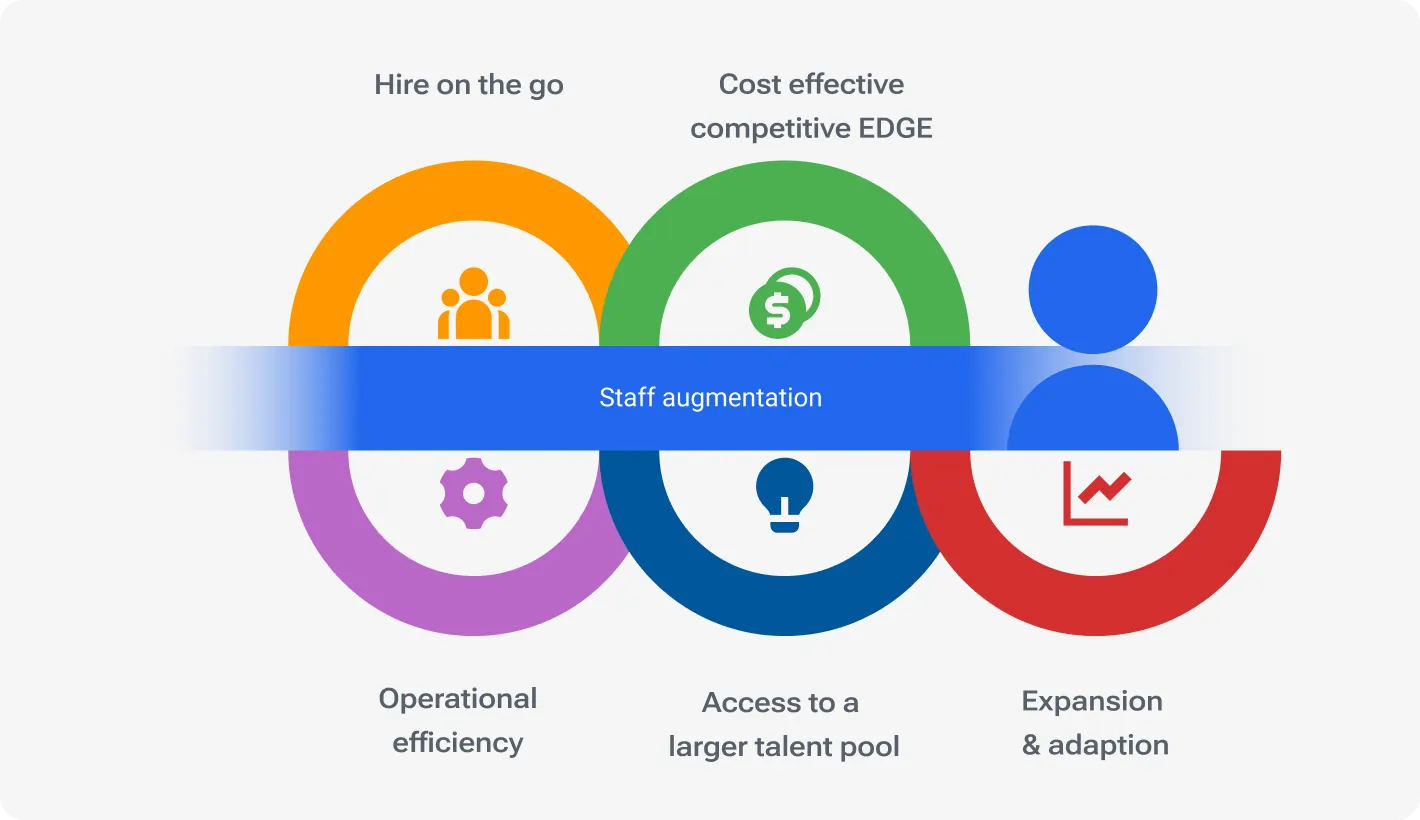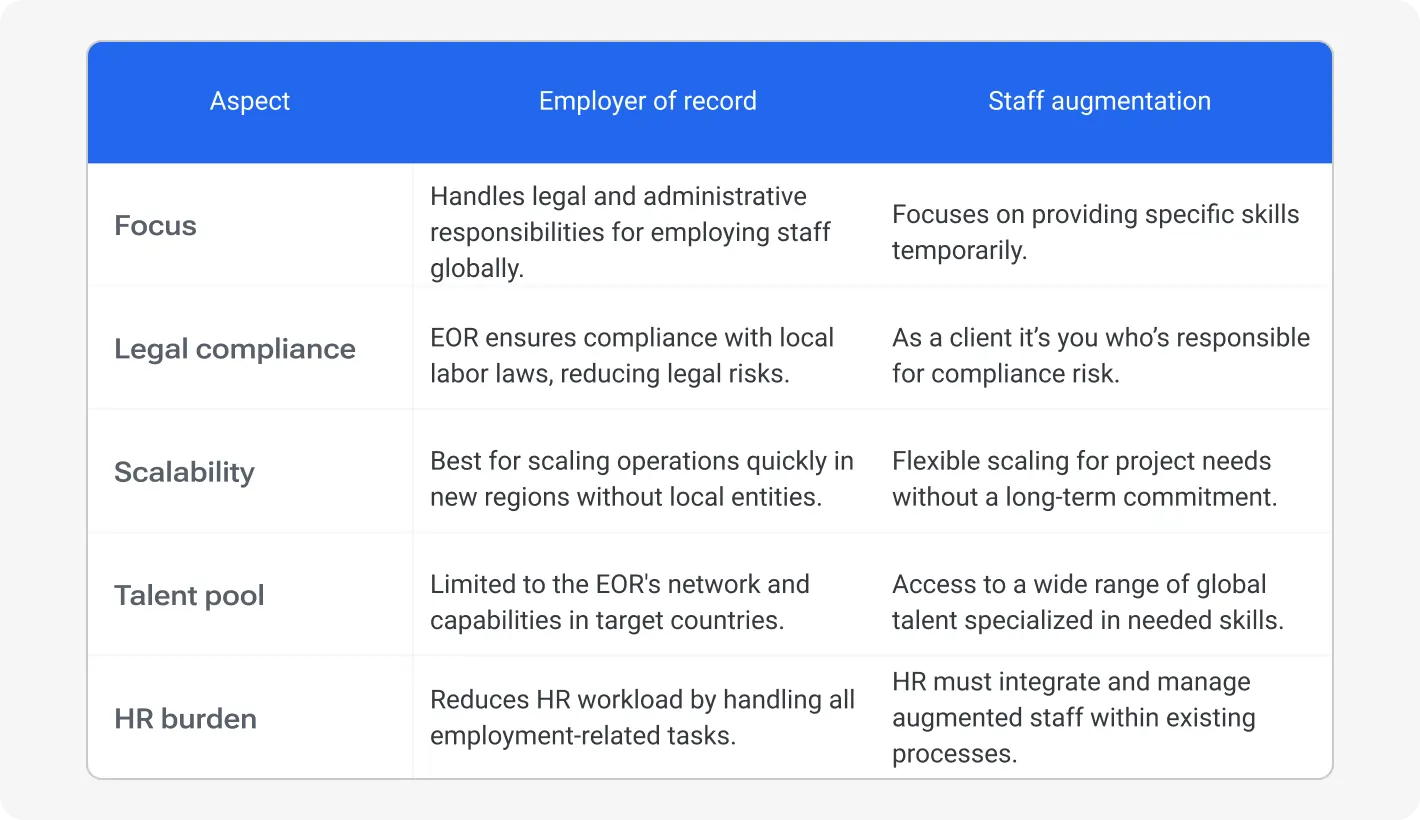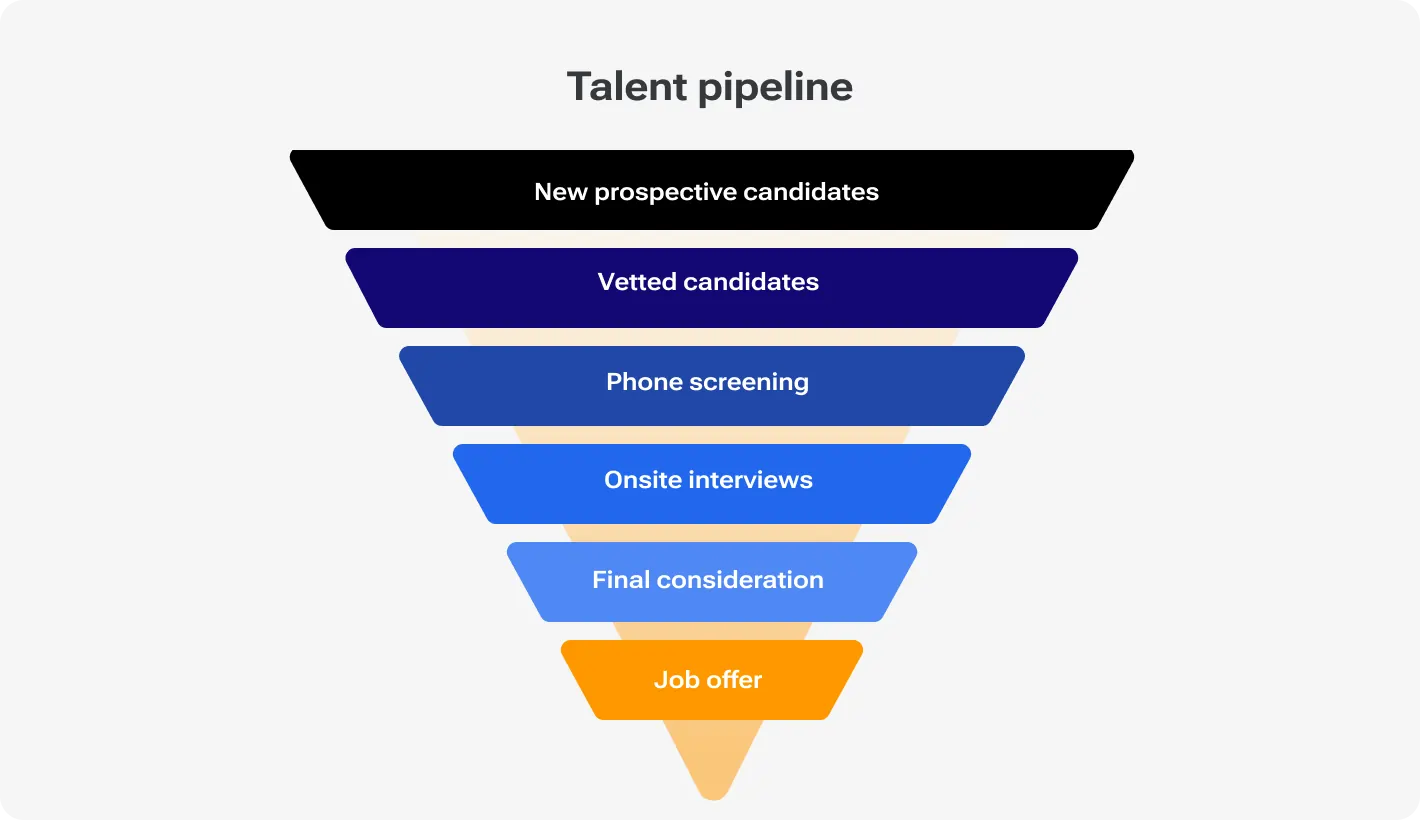Any talent sourcer or HR will say the labor market skyrocketed in recent years. But there is a thing: what type of cooperation is the most profitable currently? Let’s look at the numbers.
Robert Half, a staff augmentation star, saw USD 7.2 billion in revenue in 2022. Clear-cut pointer to the growing demand for flexible workforce solutions. The time is ripe for specialized skill sets without the complexities of full-time hires.
Here's where things can get tricky. Staff augmentation has a vast amount of advantages, yet the Employer of Record (EOR) model presents a compelling alternative. While many are mulling over Employer of Record vs. staff augmentation, an EOR simplifies the complexities of employing people internationally. These companies manage everything from payroll to compliance with local employment laws, which can be particularly advantageous for companies looking to expand globally (and safely).
However, the nuances between these two options usually create confusion. How exactly do EORs differ from staff augmentation? While both offer a path to acquiring talent, understanding these distinctions is crucial for making informed decisions about your workforce strategy.
Employer of record deep dive
An Employer of Record is basically the legal employer for tax and compliance purposes. Such providers handle human resources and other tasks that go beyond the day-to-day management of employees. Employer of Record definition is easier to understand through examples.
In a theater, there is always a backstage crew. Just as they manage the technical details – lights, sound, and scene changes – an EOR runs employment paperwork and regulatory compliance, while you can concentrate on business objectives.
Let’s take it from another side. Imagine you're a marketing agency that just hired a social media whiz in London. Chances are (if you’ve never been to Britain) a legal entity in the UK will seem to you like a logistical mess. An EOR becomes your "boots on the ground" in London, officially employing your social media pro and handling everything from payroll and taxes to work visas and compliance. You, on the other hand, maintain direct control over the work and manage your new team members just like any other employee.
Backing up and real-life example is Deel. You may have heard of it as a global company that has helped to hire and onboard employees in over 150 countries. Legal and administrative tasks of employment (local tax submissions and adherence to local employment laws, in particular) are all their duty.
What’s else?
Payroll and taxes: You won’t get in a pickle, hands down. You must pay your newcomers correctly, as well as manage all local, state, and federal taxes. EOR covers that all.
Benefits administration: If you offer benefits like health insurance, the EOR can manage enrollment and ensure compliance with local regulations.
Onboarding: The onboarding process for your new hires can also be covered by EOR. This way, the new workforce will have everything they need, and you won’t have a headache.
Easily recruit and manage employees in any country where you lack a legal presence, paying up to 40% less than you would for local talent
Staff augmentation explained
Staff augmentation is like bringing in the "hired guns" for your workforce. To be more official, staff augmentation is a type of outsourcing when you hire tech talent globally and manage augmented team members directly, just as they would with their on-site employees.
Chances are you have visited any masterclasses. If the class consists not only of learners but of true expert guests as well, the learning experience will change drastically.
Another comparison. Imagine you're a chef running a popular restaurant. Suddenly, you get a booking for a large party and need more hands to ensure the meal is a success. So, chances are you will temporarily hire (augment) experienced chefs and sous chefs for this evening — people who can step in and match the pace and style of your kitchen without skipping a beat.
Similarly, staff augmentation allows you to quickly add experienced developers to your existing team, giving you the extra firepower needed to get the job done on time.
Benefits of staff augmentation
Flexibility: “Invite” pros to your team when scaling (or just need them). Or down the team size, if you face a lowering in demand.
Control: Maintain control over management and the direction of the project, unlike project outsourcing where you might lose this control.
Expertise: Sometimes, it’s difficult to find appropriate specialists locally. Yet, where there is a will there's a way — you can find them anywhere.
Cost-effectiveness: Potentially lower costs compared to increasing permanent staff, especially when dealing with temporary or project-specific needs.
Integration: Augmented staff integrate into your existing workflows and company culture, providing more cohesion than external contractors might.
Explore how IT staff augmentation slashes costs while boosting efficiency
How it works: 4 steps
-
Identify your needs: Define the specific skills and experience required for your project or team gap.
-
Find a Partner: Staff augmentation providers maintain a diverse professional network and can help you find the perfect fit for your needs.
-
Onboard and manage: Onboard and provide everything they need to adapt. Then they will manage the administrative tasks associated with the contracted workers.
-
Transit: Once the project is complete or the skills gap is filled, the contracted workers transition out of your team.
Key difference: With staff augmentation, the contracted workers are technically employed by the augmentation provider, not your company. The augmentation company handles payroll, taxes, and other HR functions for these workers.
Comparative analysis: EOR vs. staff augmentation
The employer of record vs staff augmentation battle is defined by your company's specific needs regarding global expansion, compliance, workforce flexibility, and cost management. Below, we built a table; use it when hem and haw which option to choose.
Top 3 tips when choosing
-
Size up your needs: Are you looking to fill a permanent role or address a temporary skill gap? For long-term needs, an EOR might be a better fit. For temporary projects, staff augmentation offers more flexibility.
-
Control matters: How much control do you need over your remote workers? If you are the founder who wants to quit “operating chores”, look for services with higher responsibility and ownership. With an EOR, you maintain direct control over work assignments and performance. When augmenting staff, providers typically manage this scope themselves.
-
Cost transparency: Compare an EOR's fixed fee structure with the agency markup on staff augmentation. Factor in additional costs like benefits administration when making your decision.
Think twice whether you need all that hiring burden
Strategic implementation considerations
Employers of Record may be very helpful when… Let’s list typical scenarios when EOR is better than staff augmentation and vice versa. Spoiler: there are no ideal options, it hinges on the context and your needs.
Play long with EOR
-
Long-term remote hires: Great for companies wanting to employ staff in locations where they don't have an office.
-
Global workforce expansion: Useful for businesses planning to enter new markets without establishing a physical presence.
-
Reduced HR workload: Helps companies that prefer to outsource complex HR tasks and focus on core business activities.
Examples to learn from
GitLab: With a completely remote workforce spread across numerous countries, GitLab uses an EOR to handle various legal and administrative aspects of employment, enabling it to focus on its core operations without the burdens of HR management complexities.
Canonical: The company behind Ubuntu, Canonical, employs staff in more than 30 countries. So the EOR model is very helpful in managing diverse regulatory and compliance requirements efficiently.
Get a short-term leg-up with staff augmentation
-
Short-term projects: Adapt quickly to project demands with the right skills.
-
Accessing specialized skills: With staff augmentation it’s much easier to fill gaps in your team’s expertise, especially for project-specific technologies or methodologies.
-
Managing workload fluctuations: Scale the workforce up or down based on your current needs without the long-term commitment of hiring permanent staff.
Examples to learn from
Google: Staff augmentation helps the tech giant handle spikes in workload, particularly when developing new products or during major updates to existing products. This way, Uncle Google keeps pace with innovation demands without permanently increasing its headcount.
JPMorgan Chase: Acquires specialized financial analysts and IT experts for short-term projects that require niche skills. JPMorgan enhances their capacity to handle complex analyses and system upgrades that are beyond the scope of their regular workforce.
Main takeaway
Understand your workforce needs first. Sometimes it can be a time-consuming thing. However, it’s vital for further implementation. List your strategic goals to choose EORs or staff augmentation to build a dynamic and adaptable workforce. Don't shy away from experimenting and see which solution best fuels your company's growth journey.
To sum it up
Defining your business goals currently? EORs and staff augmentation could be your tools for scaling and growth. Employers of record are your global HR partners. They handle the legal and administrative headaches of hiring remote talent — think payroll, taxes, and compliance — so you can focus on building your dream team.
Staff Augmentation acts as your "hired guns," providing access to specialized skills and expertise to tackle short-term projects or address skill gaps within your existing team. There is no one-size-fits-all solution, and we can’t advise you at the drop of a hat since no one knows your goals better than you. Yet, if you’re looking to build a long-term remote team or need a temporary boost for a critical project, Devico is here to help. Whether you will go with us or with another company, you can always find a solution on the free 1-hour Zoom/Meet with our experts.
Want to know how your business may benefit from EOR?






